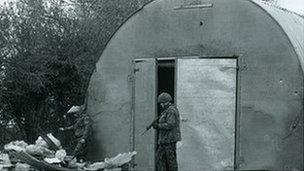'Shoot to kill' verdict: Martin McCaughey's family in inquest challenge
- Published

The IRA men were shot more than 30 times at an isolated shed near Loughgall in County Armagh
The family of one of two IRA men shot dead by SAS soldiers in 1990 are trying to overturn an inquest jury's verdict that found the killings were justified.
Martin McCaughey and Dessie Grew were both armed with AK47 rifles when they were shot more than 30 times by an SAS unit near Loughgall in County Armagh.
The ruling in May was NI's first "shoot to kill" verdict in about 30 years.
At Belfast High Court on Friday, the McCaughey family's lawyers claimed that evidence was withheld from the jury.
They also argued the inquest was flawed because one of the soldiers who had given evidence failed to return for further questioning.
Stolen car
Neither IRA man fired any shots on the night of their deaths in October 1990, provoking claims that soldiers could have arrested them instead.
In submissions on behalf of the family, Karen Quinlivan QC argued that the inquest jury was denied access to material relevant to questions on whether the SAS were involved in a shoot to kill policy and whether the soldier's use of lethal force was justified.
The men's families had campaigned for an inquest into their deaths for over two decades.
In May, the jury found that the pair had been lawfully killed, ruling that the SAS had used reasonable force during the operation and that the IRA men's own actions had contributed to their deaths.
According to their verdict, Mr Grew, 37, and Mr McCaughey, 23, put their own lives in danger by being in the area close to a stolen car which was expected to be used in terrorist activity.
Both men were said to be armed with guns, wearing gloves, balaclavas and were approaching soldiers who believed that their lives were in immediate danger.
However, on Friday, lawyers representing McCaughey's sister sought leave to judicially review verdicts reached by the jury.
They argued that the inquest failed to comply with procedural protections guaranteed under European law, and failed to constitute an independent and effective investigation into the deaths.
'Fatally wounded'
A key complaint centred on the failure to secure the re-attendance at the hearing of a military witness identified only as Soldier A.
He was also linked to the use of lethal force in the SAS shooting of another IRA man, Francis Bradley, four years earlier.
Soldier A, who led the unit which shot Mr Grew and Mr McCaughey, initially gave evidence at the inquest.
However, he failed to return to the hearing after it was ruled he could be questioned about his involvement in the Bradley shooting and about evidence appearing to show that all three IRA men had been shot while lying fatally wounded on the ground.
Setting out a series of criticisms of the inquest, Ms Quinlivan added: "It was ineffective because material evidence was withheld from the inquest jury, meaning that the inquest was not capable of leading to a determination of whether the force used was justified in the circumstances.
'Right guidance'
"It was ineffective because the jury were not properly directed and consequently failed to address key issues in the case."
But Gerald Simpson QC, for the coroner, insisted the jury was given the right guidance.
He pointed out that the inquest ran for nearly 30 days and urged the judge not to "second guess" the coroner without going through all evidence in detail.
Mr Justice Weatherup, who heard the challenge, reserved his decision on whether to grant leave to apply for a judicial review.
- Published3 May 2012
- Published12 March 2012